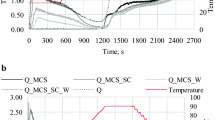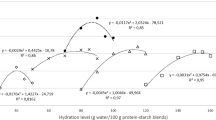Abstract
The impact of acid incorporation (acetic + lactic, 0.5 %) into rice starch-based doughs enriched with different proteins (egg albumin, calcium caseinate, pea and soy protein isolates) at different doses (0, 5 and 10 %) was investigated on dough proofing and thermal properties, and bread quality evaluated from physical and sensory measurements. Proteins from vegetable sources led to breads with lower-specific volume and harder crumb, effects being magnified with protein dose and reduced with acid addition. Incorporation of proteins from animal source resulted in different behaviours according to the protein type, dosage and acidification. Protein addition increased the dough pH and total titratable acidity and reduced the impact of acid addition on dough acidity. Albumin-added doughs had significantly higher temperature of gelatinization than most of the other supplemented doughs, while vegetable proteins led to significantly lower gelatinization enthalpy than the control dough. Acid addition affected dough proofing and significantly improved the volume and texture of protein-enriched breads without detriment of either odour or taste.


Similar content being viewed by others
References
Ahlborn GJ, Pike OA, Hendrix SB, Hess WM, Huber CS (2005) Sensory, mechanical and microscopic evaluation of staling in low-protein and gluten-free breads. Cereal Chem 82:328–335
Blanco CA, Ronda F, Pérez B, Pando V (2011) Improving gluten-free bread quality by enrichment with acidic food additives. Food Chem 127:1204–1209
Chinachoti P, Vodovotz V (2011) Bread staling. CRC, Boca Ratón
Crockett R, Ie P, Vodovotz Y (2011) Effects of soy protein isolate and egg white solids on the physicochemical properties of gluten-free bread. Food Chem 129:84–91
Damodaran S (2008) Aminoácidos, Péptidos y Proteínas. In: Damodaran S, Parkin KL, Fenema OR (eds) Fenemma Química de los Alimentos. Editorial ACRIBIA S.A. Zaragoza, España, pp 215–325
Eliasson AC, Larsson K (1993). Interactions between components. In Cereals in breadmaking: a molecular colloidal approach. Marcel Dekker, New York, pp 161–201
Eliasson A (1994) Interactions between starch and lipids studied by DSC. Thermochim Acta 246:343–356
Gallagher E, Kunkel A, Gormley TR, Arendt EK (2003) The effect of dairy and rice powder addition on loaf and crumb characteristics, and on shelf life (intermediate and long-term) of gluten-free breads stored in a modified atmosphere. Eur Food Res Technol 218:44–48
Gallagher E, Gormley TR, Arendt EK (2003) Crust and crumb characteristics of gluten free brads. J Food Eng 56:152–161
Gallagher E (2009) Gluten-free. Food Science and Technology. Wiley, London
Gujral HS, Rosell CM (2004) Improvement of the breadmaking quality of rice flour by glucose oxidase. Food Res Int 37:75–81
Hibi Y (2002) Effects of salt, sugar and vinegar on melting of the amylose–lipid complex in rice starch. J Home Econ Japan 53:805–810
Jayaram VB, Cuyvers S, Verstrepen KJ, Delcour JA, Courtin CM (2014) Succinic acid in levels produced by yeast (Saccharomyces cerevisiae) during fermentation strongly impacts wheat bread dough properties. Food Chem 151:421–428
Jekle M, Becker T (2012) Effects of acidification, sodium chloride, and moisture levels on wheat dough: I. Modeling of rheological and microstructural properties. Food Biophys 7:190–199
Kelly AL, Moore MM, Arendt EK (2008) 18—New product development: the case of gluten-free food products. In: Arendt EK, Bello FD (eds) Gluten-free cereal products and beverages. Academic Press, San Diego, pp 413–431
Kittisuban P, Ritthiruangdej P, Suphantharika M (2014) Optimization of hydroxypropylmethylcellulose, yeast β-glucan, and whey protein levels based on physical properties of gluten-free rice bread using response surface methodology. LWT—Food Sci Technol 57:738–748
Krebs HA, Wiggins D, Stubbs M, Sols A, Bedoya F (1983) Studies on the mechanism of the antifungal action of benzoate. Biochem J 214:657–663
Lazaridou A, Duta D, Papageorgiou M, Belc N, Biliaderis CG (2007) Effects of hydrocolloids on dough rheology and bread quality parameters in gluten-free formulations. J Food Eng 79:1033–1047
Marco C, Rosell CM (2008) Breadmaking performance of protein enriched, gluten-free breads. Eur Food Res Technol 227:1205–1213
Marco C, Rosell CM (2008) Effect of different protein isolates and transglutaminase on rice flour properties. J Food Eng 84:132–139
Moore M, Dal Bello F, Arendt EK (2008) Sourdough fermented by Lactobacillus plantarum FST 1.7 improves the quality and shelf life of gluten-free bread. Eur Food Res Technol 226:1309–1316
Noisuwan A, Bronlund J, Wilkinson B, Hemar Y (2008) Effect of milk protein products on the rheological and thermal (DSC) properties of normal rice starch and waxy rice starch. Food Hydrocolloids 22:174–183
Ohishi K, Kasai M, Shimada A, Hatae K (2007) Effects of acetic acid on the rice gelatinization and pasting properties of rice starch during cooking. Food Res Int 40:224–231
Osella CA, Sánchez HD, Carrara CR, de la Torre MA, Buera MP (2005) Water redistribution and structural changes of starch during storage of a gluten-free bread. Starch 57:208–216
Peres MFS, Tininis CRCS, Souza CS, Walker GM, Laluce C (2005) Physiological responses of pressed baker’s yeast cells pre-treated with citric, malic and succinic acids. World J Microbiol Biotechnol 21:537–543
Pérez-Quirce S, Collar C, Ronda F (2014) Significance of healthy viscous dietary fibres on the performance of gluten-free rice-based formulated breads. Int J Food Sci Technol 49:1375–1382
Piper P, Calderon CO, Hatzixanthis K, Mollapour M (2001) Weak acid adaptation: the stress response that confers yeasts with resistance to organic acid food preservatives. Microbiology 147:2635–2642
Purlis E (2010) Browning development in bakery products—a review. J Food Eng 99:239–249
Pyler EJ, Gorton LA (2000) Fundamental bakery dough processes. In: Baking science & technology, volume II: formulation and production. Sosland, Kansas City, pp 1–134
Ribotta PD, Ausar SF, Morcillo MH, Pérez GT, Beltramo DM, León AE (2004) Production of gluten-free bread using soybean flour. J Sci Food Agric 84:1969–1974
Ronda F, Caballero PA, Quilez J, Roos YH (2011) Staling of frozen partly and fully baked breads. Study of the combined effect of amylopectin recrystallization and water content on bread firmness. J Cereal Sci 53:97–103
Ronda F, Quilez J, Pando V, Roos YH (2014) Fermentation time and fiber effects on recrystallization of starch components and staling of bread from frozen part-baked bread. J Food Eng 131:116–123
Ronda F, Villanueva M, Collar C (2014) Influence of acidification on dough viscoelasticity of gluten-free rice starch-based dough matrices enriched with exogenous protein. LWT—Food Sci Technol 59:12–20
Stratford M (1999) Traditional preservatives – Organic acids. In: Robinson RK, Batt CA, Patel PD (eds) Encyclopedia of food microbiology. Academic Press, New York
Witczak M, Korus J, Ziobro R, Juszczak L (2010) The effects of maltodextrins on gluten-free dough and quality of bread. J Food Eng 96:258–265
Zayas JF (1997). Functionality of proteins in food. Springer, Berlin, Heidelberg, Germany, pp 6–75
Ziobro R, Korus J, Witczak M, Juszczak L (2012) Influence of modified starches on properties of gluten-free dough and bread. Part II: quality and staling of gluten-free bread. Food Hydrocoll 29:68–74
Ziobro R, Witczak T, Juszczak L, Korus J (2013) Supplementation of gluten-free bread with non-gluten proteins. Effect on dough rheological properties and bread characteristic. Food Hydrocoll 32:213–220
Zobel HF, Kulp K (1996) The staling mechanism. In: Hebeda RE, Zobel HF (eds) Baked goods freshness: technology, evaluation and inhibition of staling. Marcel Dekker, New York
Acknowledgments
The research was supported by the Spanish Institutions Ministerio de Economía y Competitividad and the European Regional Development Fund (FEDER) (Projects AGL2012-35088 and AGL2011-22669), and Comunidad de Castilla y León (Project VA252A12-2). Special thanks to Sandra Pérez-Quirce for her help in baking and other laboratory tasks. Marina Villanueva thanks the Junta de Castilla y León doctorate grant
Conflict of interest
None.
Compliance with Ethics Requirements
This article does not contain any studies with human or animal subjects.
Author information
Authors and Affiliations
Corresponding author
Rights and permissions
About this article
Cite this article
Villanueva, M., Mauro, R.R., Collar, C. et al. Acidification of protein-enriched rice starch doughs: effects on breadmaking. Eur Food Res Technol 240, 783–794 (2015). https://doi.org/10.1007/s00217-014-2384-8
Received:
Revised:
Accepted:
Published:
Issue Date:
DOI: https://doi.org/10.1007/s00217-014-2384-8




